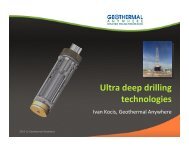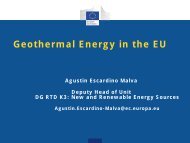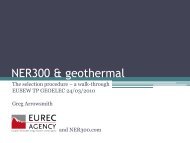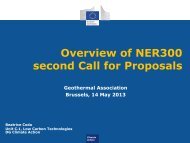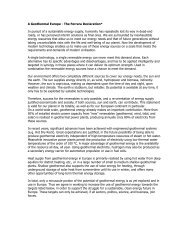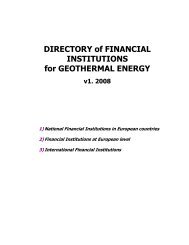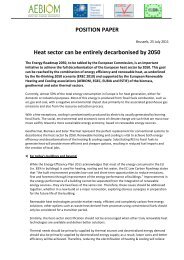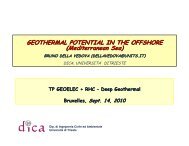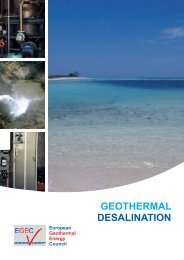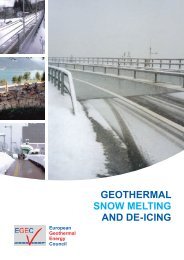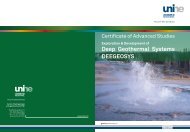Strategic Research and Innovation Agenda for Renewable ... - EGEC
Strategic Research and Innovation Agenda for Renewable ... - EGEC
Strategic Research and Innovation Agenda for Renewable ... - EGEC
You also want an ePaper? Increase the reach of your titles
YUMPU automatically turns print PDFs into web optimized ePapers that Google loves.
9<strong>Strategic</strong> <strong>Research</strong> <strong>and</strong> <strong>Innovation</strong> <strong>Agenda</strong> <strong>for</strong> <strong>Renewable</strong> Heating & CoolingOutlook on the Implementation RoadmapThe present chapter aims at providing an overview of the total resources required <strong>for</strong> thesuccessful implementation of this <strong>Strategic</strong> <strong>Research</strong> <strong>and</strong> <strong>Innovation</strong> <strong>Agenda</strong> in Europe.The in<strong>for</strong>mation provided is based on a quantitative analysis of funding <strong>for</strong> RHC research,development <strong>and</strong> demonstration from the public <strong>and</strong> private sectors in the period 2007-2012<strong>and</strong> the expected funding trends to 2020, which rely on a number of assumptions developedby the RHC-Plat<strong>for</strong>m 81 . It must be noted that available data is incomplete <strong>and</strong> the in<strong>for</strong>mationconcerning public investments in R&D <strong>for</strong> several Member States was not available. As <strong>for</strong>statistics of heating <strong>and</strong> cooling consumption, data on resources allocated to RHC R&D arefragmented <strong>and</strong> research activities are measured according to heterogeneous indicators(also due to the diversity of the underlying RES). A complete overview is virtually impossibledue to the scientific <strong>and</strong> policy interdisciplinarity of RHC systems. The multitude of fundinginstitutions <strong>and</strong> programmes at Member State (MS) level further complicates data collection.The RHC-SRA will be implemented with resources from various sources, dependingon the nature of the research <strong>and</strong> innovation priorities <strong>and</strong> specific needs of the individualtechnologies. The following sections present the three complementary routes considered toleverage resources required to implement the RHC-SRA:1. Public funding <strong>for</strong> R&D at EU level2. Public funding <strong>for</strong> R&D at MS level3. Investments by the private sectorThe chapter concludes with an estimate of the budget <strong>and</strong> investments which will benecessary <strong>for</strong> implementing the RHC-SRA.lal9.1 Public funding <strong>for</strong> R&D at EU levelThe starting point <strong>for</strong> the characterisation of the EU funding <strong>for</strong> R&D was a mapping ofall projects high financially T supported by the European Commission in the fields of reference.Solar collectorssemi-high TA recent study of EURAC research 82 analysed all funds allocated medium T by the EU within the“Work Programme Energy” of the Seventh Framework Programme <strong>for</strong> <strong>Research</strong> <strong>and</strong>low TTechnological Development (FP7) over the period 2007-2012 in terms of EC contribution,overall budget <strong>and</strong> distribution between the technology paths. This study providesthe following in<strong>for</strong>mation:• 29 projects directly relevant to RHC received financial support by the EC• 137.7 mln Euro: Estimated total budget of RHC R&D projects• 85.2 mln Euro: Estimated total EC contribution to RHC R&D projectsCHP plant Industry Buildings Passive buildings, agricultureAlthough a complete overview of the FP7 was not available at the time of writing, somekey trends are already Input from deep visible. geothermal,HT storage options LTFigure 44 shows that resources allocated to RHC R&D underbiomass, large solar thermalFP7 are negligible in comparison with those allocated to nuclear energy or R&D related toother energy technologies.100% RHC 1%Other H&C 6%80%60%40%20%0%Euratom 69%RES electricity 14%Other energy R&D(non-nuclear) 10%100% = 7.6 bn.€Funding <strong>for</strong> energy researchunder FP7 (2007-2013)100% = 1,180 MtoeFinal energy consumptionin EU in 2010Other H&C 14%H&C 33%Electricity 21%Transport 32%Figure 44: Funding <strong>for</strong> energy research under FP7 <strong>and</strong> final energy consumption by sector(Authors’ adaptation based on: Pezzutto, S. & Sparber, W. (2013); EU Energy in Figures 2012)81These assumptions do notreflect any <strong>for</strong>mal commitmentof EU Institutions or MemberStates regarding the futurelevel of funding allocatedto RHC technologies.The RHC-Plat<strong>for</strong>m is thesole responsible <strong>for</strong> theestimations presentedin this publication.82Pezzutto, S. & Sparber, W(2013). It should be notedthat some of the projectsconsidered deal with RES <strong>for</strong>the production of both thermalenergy <strong>and</strong> electrical energy.In these cases, the authorsestimated the share ofthe total budget which isdedicated to RHC R&D.84Private Investments 60% European Commission 20%EUR 800 million



